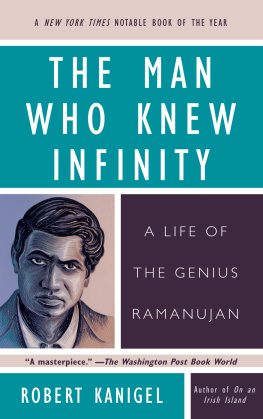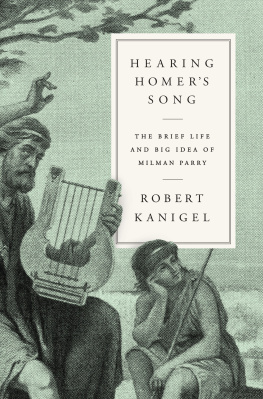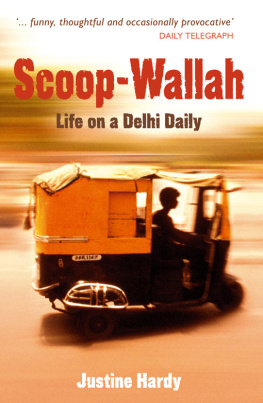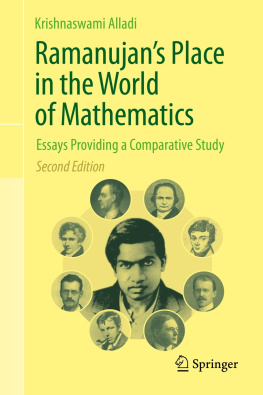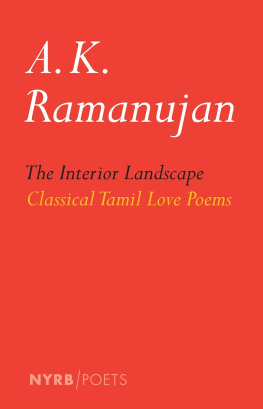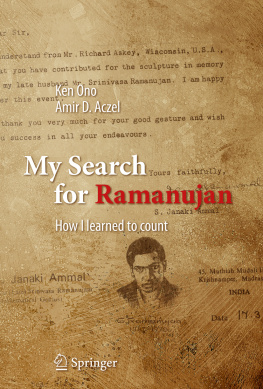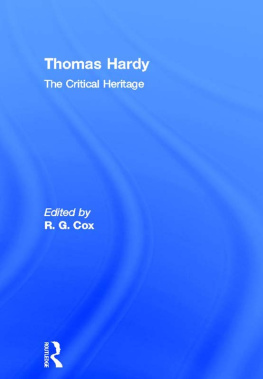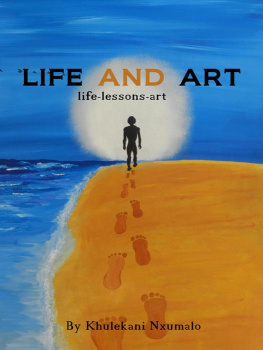A gem.... What Mozart was to music and Einstein was to physics, Ramanujan was to math....
Clifford Stoll, author of The Cuckoos Egg and Silicon Snake Oil
EXTRAORDINARY PRAISE FOR ROBERT KANIGELS

ENLIGHTENING.... a magic, tragic ugly-duckling fable....Ramanujans remarkable story comes through....
The New York Times
The most luminous expression ever of... genius interacting with genius... Ive seen nothing to compare with it.
Hugh Kenner, BYTE
ENTHRALLING... one of the best scientific biographies Ive ever seen.
Dr. John Gribbin, author of In Search of Shrdingers Cat
COMPELLING... a work of arduous research and rare insight... Kanigel deserves high praise.
Booklist
... a REMARKABLE book.... a model of the biographers art: Kanigel has taken a man, a social context and a specialist field and made each accessible and convincing. He has done so with a rare combination of skillsencyclopedic thoroughness, meticulous research, genuine sympathy for his subjects and first-rate writing of exceptional lucidity and verve. THOUGHTFUL, COMPASSIONATE AND CLEAR, THE MAN WHO KNEW INFINITY IS A MASTERPIECE.... BREATHTAKING.
The Washingon Post Book World
A BOOK-OF-THE-MONTH-CLUB
FEATURED SELECTION
FINALIST FOR THE LOS ANGELES TIMES BOOK AWARD
BRILLIANTLY REALIZED.... [the] fascinating story of a difficult but astoundingly fruitful cross-cultural collaboration.
Kirkus Reviews
THE MAN WHO KNEW INFINITY is an accessible look at an almost romantic episode in the enormously rich intellectual world of mathematics... Robert Kanigel also gives a real sense of Ramanujans creative compulsion which, like Mozarts, contained the seeds of both success and tragedy.
Baltimore Evening Sun
... more fascinating than a novel... a verbal portrait, A VIRTUAL MASTERPIECE, complete with vibrant scenes from all the places graced by the presence of Ramanujan.... ENCHANTING.
Lexington Herald-Leader (Kentucky)
THE MAN WHO KNEW INFINITY tells of the plight of unrecognized genius.... this story of romance with mathematics makes for lively reading... with a heartbreaking end.
Christian Science Monitor
SPLENDID... One of Robert Kanigels achievements in THE MAN WHO KNEW INFINITY is to make the math magic... accessible.... a very human story.... EXCITING.
San Diego Union
[A] SUPERBLY CRAFTED biography.... Kanigel succeed[s] in giving a taste of Ramanujan the mathematician, but his exceptional triumph is in the telling of this wonderful human story.... a pleasure to read... THE MAN WHO KNEW INFINITY is a thoughtful and deeply moving account of a signal life.
Science
A simple story VIVIDLY TOLD.... Kanigel excels in descriptions that will appeal to both the lay and scholarly reader.
San Francisco Chronicle
PERSPICACIOUS, INFORMED, IMAGINATIVE, THE MAN WHO KNEW INFINITY is... the best mathematical biography I have ever read.
The New York Review of Books
[An] extremely well-researched and well-written biography.
Library Journal
Mr. Kanigel has a wonderful gift.... The drama of Ramanujans Spring and Autumn comes through magnificently.
Freeman Dyson, author of Disturbing the Universe
MOVING AND ASTONISHING.
Publishers Weekly
THE MAN WHO KNEW INFINITY is a story at least as compelling as Brian Epsteins discovery of the Beatles... [a] richly detailed road map to strange, wondrous foreign cultures.... Kanigel expertly intertwines the details of Ramanujans odd, doomed life with his soaring professional accomplishments.
Los Angeles Times Book Review
Thank you for downloading this Washington Square Press eBook.
Join our mailing list and get updates on new releases, deals, bonus content and other great books from Washington Square Press and Simon & Schuster.
C LICK H ERE T O S IGN U P
or visit us online to sign up at
eBookNews.SimonandSchuster.com

Contents

For Mom and Dad
with love and thanks


Prologue

One day in the summer of 1913, a twenty-year-old Bengali from an old and prosperous Calcutta family stood in the chapel of Kings College in the medieval university town of Cambridge, England. A glorious, grandly proportioned place, more cathedral than chapel, it was the work of three kings of England going back to 1446. Light streamed in through stained glass panels ranging across the south wall. Great fluted columns reached heavenward, flaring out into the massive splayed vault of the roof.
Prasantha Chandra Mahalanobis was smitten. Scarcely off the boat from India and planning to study in London, he had come up on the train for the day to sightsee. But now, having missed the last train back to London and staying with friends, he couldnt stop talking about the chapel and its splendors, how moved hed been, how...
Perhaps, proposed a friend, he should forget London and come to Kings instead. That was all Mahalanobis needed to hear. The next day he met with the provost, and soon, to his astonishment and delight, he was a student at Kings College, Cambridge.
He had been at Cambridge for about six months when his mathematics tutor asked him, Have you met your wonderful countryman Ramanujan?
He had not yet met him, but he had heard of him. Ramanujan was a self-taught mathematical prodigy from a town outside Madras, in South India, a thousand miles from the sophisticated Calcutta that Mahalanobis knew best, a world as different from his own as Mahalanobiss was from England. The South, as educated North Indians were wont to see it, was backward and superstitious, scarcely brushed by the enlightened rationality of Bombay and Calcutta. And yet, somehow, out of such a place, from a poor family, came a mathematician so alive with genius that the English had practically hand-delivered him to Cambridge, there to share his gifts with the scholars of Trinity College and learn whatever they could teach him.
Among the colleges of Cambridge University, Trinity was the largest, with the most lustrous heritage, home to kings, poets, geniuses. Isaac Newton himself had studied there; since 1755, his marble likeness, holding the prism hed used to explore the polychromatic nature of light, stood in its chapel. Lord Byron had gone to Trinity. So had Tennyson, Thackeray, and Fitzgerald. So had the historian Macaulay, and the physicist Rutherford, and the philosopher Bertrand Russell. So had five English prime ministers.
And now, Ramanujan was at Trinity, too.
Soon Mahalanobis did meet him, and the two became friends; on Sunday mornings, after breakfast, theyd go for long walks, talk about life, philosophy, mathematics. Later, looking back, Mahalanobis would date the flowering of their friendship to one day in the fall following Ramanujans arrival. Hed gone to see him at his place in Whewells Court, a three-story stone warren of rooms built around a grassy quadrangle laced with arched Gothic windows and pierced at intervals by staircases leading to rooms. One such portal led to Ramanujans small suite, on the ground floor, a step or two off the court.
Next page
